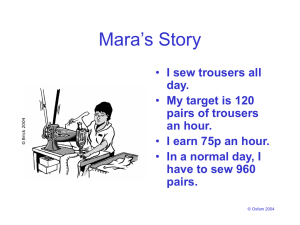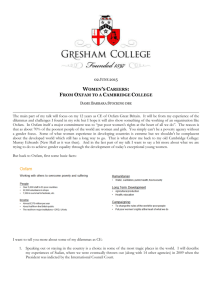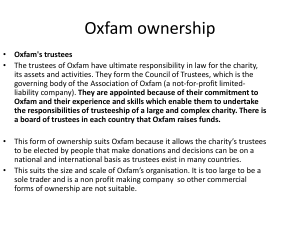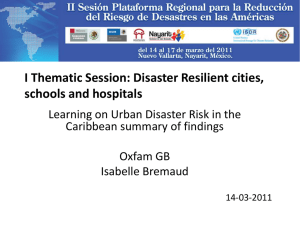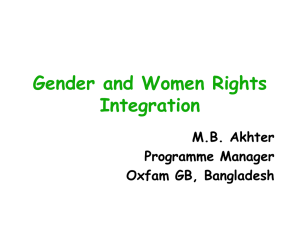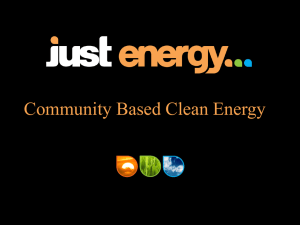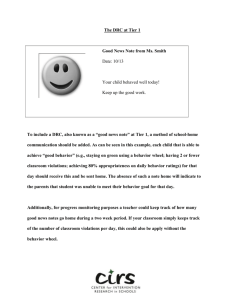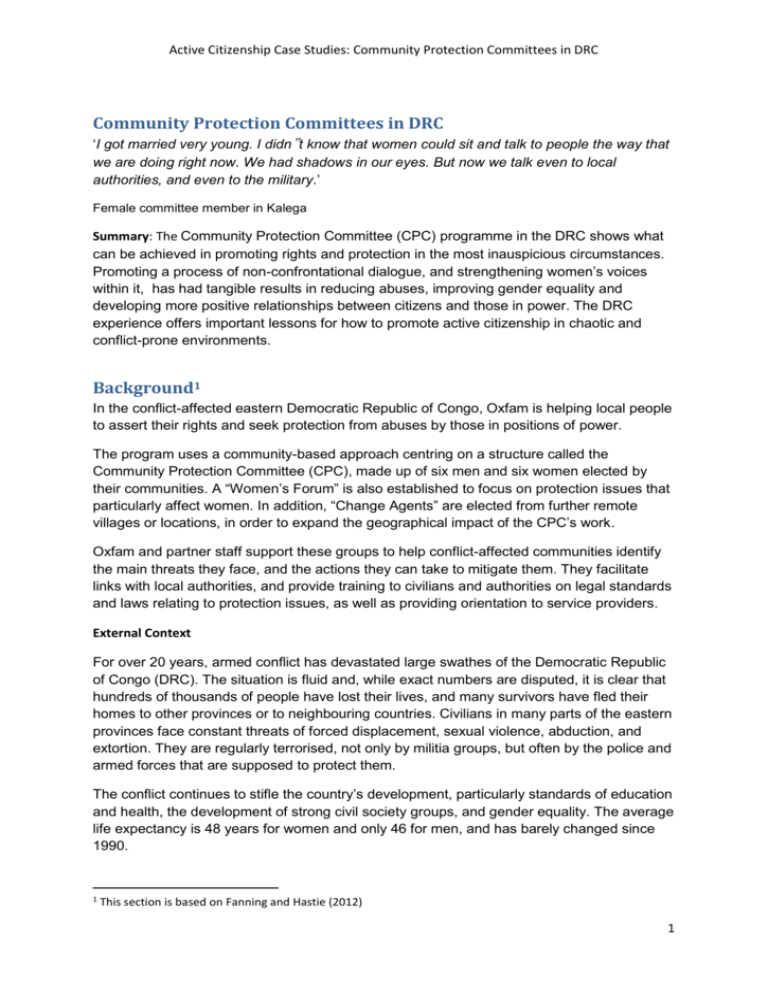
Active Citizenship Case Studies: Community Protection Committees in DRC
Community Protection Committees in DRC
‘I got married very young. I didn‟t know that women could sit and talk to people the way that
we are doing right now. We had shadows in our eyes. But now we talk even to local
authorities, and even to the military.’
Female committee member in Kalega
Summary: The Community Protection Committee (CPC) programme in the DRC shows what
can be achieved in promoting rights and protection in the most inauspicious circumstances.
Promoting a process of non-confrontational dialogue, and strengthening women’s voices
within it, has had tangible results in reducing abuses, improving gender equality and
developing more positive relationships between citizens and those in power. The DRC
experience offers important lessons for how to promote active citizenship in chaotic and
conflict-prone environments.
Background1
In the conflict-affected eastern Democratic Republic of Congo, Oxfam is helping local people
to assert their rights and seek protection from abuses by those in positions of power.
The program uses a community-based approach centring on a structure called the
Community Protection Committee (CPC), made up of six men and six women elected by
their communities. A “Women’s Forum” is also established to focus on protection issues that
particularly affect women. In addition, “Change Agents” are elected from further remote
villages or locations, in order to expand the geographical impact of the CPC’s work.
Oxfam and partner staff support these groups to help conflict-affected communities identify
the main threats they face, and the actions they can take to mitigate them. They facilitate
links with local authorities, and provide training to civilians and authorities on legal standards
and laws relating to protection issues, as well as providing orientation to service providers.
External Context
For over 20 years, armed conflict has devastated large swathes of the Democratic Republic
of Congo (DRC). The situation is fluid and, while exact numbers are disputed, it is clear that
hundreds of thousands of people have lost their lives, and many survivors have fled their
homes to other provinces or to neighbouring countries. Civilians in many parts of the eastern
provinces face constant threats of forced displacement, sexual violence, abduction, and
extortion. They are regularly terrorised, not only by militia groups, but often by the police and
armed forces that are supposed to protect them.
The conflict continues to stifle the country’s development, particularly standards of education
and health, the development of strong civil society groups, and gender equality. The average
life expectancy is 48 years for women and only 46 for men, and has barely changed since
1990.
1
This section is based on Fanning and Hastie (2012)
1
Active Citizenship Case Studies: Community Protection Committees in DRC
Weak state authority, the illegal exploitation of mineral wealth, and the ease with which
weapons enter the country has helped fuel cycles of violence, with women, men and children
caught in the crossfire. The long-term instability and insecurity has left virtually no industry
and limited opportunities for education and jobs. This provides an economic incentive for
many young men and boys, (as well as some girls), to take up arms, although they are also
often forcibly recruited.
Gender and Conflict
Women face many inequalities in the DRC. They play a very limited role in public life and
constantly confront deep-seated attitudes and beliefs that perpetuate discrimination and
gender-based violence. Following the 2006 elections, women accounted for only 9.4 per
cent of seats in the national Parliament. The adult literacy rate (age 15 and over) is 56 per
cent for women compared with 78 per cent for men. Women are also under-represented in
paid employment and are often denied rights of inheritance.
There are many similarities in how men and women assess their overall insecurity, but the
causes of insecurity and the type of threats they face – abduction, murder, arbitrary arrest,
sexual violence, illegal checkpoints, forced labour – are often different.
Men are more at risk of being killed, tortured or abducted, used for forced labour, or
imprisoned. We are frequently told that women are less likely than men to be abducted or
killed when they go to the fields, but they are at high risk of rape – which often leads to
rejection by their husbands. The survival strategies used to avoid these risks include:
choosing not to go to the fields or market, which has serious effects on well-being and
livelihoods. The alternative is to send women to do such work as a conscious family choice women may face sexual assault or other forms of taxation or exploitation, but this is
considered preferable to losing the head of household.
The conflict has, however, significantly affected traditional gender roles in what was
previously a largely patriarchal society. Women report that taking part in the various
committees set up by NGOs has given them the confidence to participate in decision-making
in their households and communities. Displacement towards urban and peri-urban centres
and nearer main roads has introduced new ideas to men and women in previously isolated
communities. Women’s traditional roles in providing for the household, often through
cultivation or small-scale trade, has become more important as men have struggled to find
livelihoods. Women’s associations and solidarity groups have enabled women to develop
more self-confidence.
However, this new role for women has, in many cases, been accompanied by a diminished
sense of self-worth among civilian men. Humanitarian interventions have primarily focused
on opportunities – economic, social and political – for women, without creating positive
opportunities for men, at a time when alternatives to participation in armed violence are
needed more than ever, particularly for young, unemployed men. Violent conflict clearly
affords certain privileges, and values ideas of manhood that are associated with aggression,
physical power and violence – ideals that devalue and belittle other, more positive models of
manhood.
Conflicts in Africa’s Great Lakes Region have been the focus of some excellent and groundbreaking research on gender roles, and sexual and other gender-based violence. However,
2
Active Citizenship Case Studies: Community Protection Committees in DRC
this has not always translated into policy and practice. In narratives of sexual violence in the
DRC, women have been simplistically presented as ‘victims’ and men as ‘criminals’ or
perpetrators of abuse. This has overlooked the fact that men are also subject to sexual and
other violence, and denied other roles for women besides ‘victimhood’. These portrayals
have had a negative impact on community dynamics, creating conflict and hostile relations
between some men and women, and reinforcing the idea of militarised masculinity and other
gender stereotypes.
Timeline
2006-7:
Oxfam makes strategic decision to address protection issues within its
water and sanitation programming.
2007
Oxfam trains staff and partners and conducts its first annual protection
survey in 17 communities in eastern DRC as basis for advocacy and for ‘mainstreaming’
protection in its programming. Findings are used to inform local level advocacy to address
immediate threats facing communities (eg roadblocks and forced labour) and to inform
MONUC mandate advocacy at global level.
2008
Oxfam develops its mainstreaming approach and appoints full-time protection staff.
2009
Protection programme gets funding
2011
expansion into new areas
2012
M23 uprising triggers mass flight. Protection committees set up in two
camps around Goma: Kanyaruchinya, and Mugunga 1. When Kanyaruchinya is attacked by
M23, and people are forced to flee, members of those CPCs become nucleus of committees
in different spontaneous camps.
Results and outcomes
‘Before, a boy went to school in Uvira, but a girl was educated in the village. It used to be
that if the parents didn’t have much money, they would only send the boy to school. Now
both study together, either in Uvira or in the village.’ Women’s Forum in Marungu (Hauts
Plateaux)
‘We used to live like cattle – now we have learned that women are people too.’ Kakolokelwa
Women’s Forum
The impacts of protection programmes are often hard to gauge due to the multiple factors
affecting the situation and the difficulty in identifying any form of causal chain. An external
evaluation of Oxfam’s DRC programme (Oxfam 2012b) found that successes cited by
committee members were not always recognised or agreed with by other community
members; likewise, measuring a concept as complex as ‘empowerment’ – which includes
subjective feelings of self-worth and confidence – is never easy. However, feedback from
communities, including statistical data, has identified some tangible positive changes. It also
suggests that the broader approach to gender – recognising the impact of conflict on men,
and not just in an instrumental way to improve the situation for women – has brought about
positive results, strengthening women’s feelings of security and empowerment.
3
Active Citizenship Case Studies: Community Protection Committees in DRC
It is particularly difficult to assess the impact of this kind of programme on taboo and underreported issues such as sexual violence. Fewer cases of reported rape might be considered
a positive indicator, but as taboos are gradually broken down, this may lead to more
reporting of rape and other sexual violence.
According to a May 2012 evaluation (Oxfam 2012a), the main positive results include:
Reduction in human rights abuses, and improvement of general protective
environment;
Improved knowledge of the population on human rights and protection laws;
Better relations with the legal authorities leading to improved accountability;
Significant improvement regarding gender equality (building women capacities and
enabling them to speak up about their specific concerns, addressing discrimination
against girls in school enrolment, women inheritance right, etc);
Strong community-ownership and commitment of the community volunteers
In terms of advocacy, the presence of the committees allows for solid communitylevel information to be passed to the advocacy team, thereby informing Oxfam’s
broader advocacy efforts..
Box: Results vary greatly with context
As in any programme in a complex, turbulent context, results have been unpredictably
influenced by the turbulent tides of violence and recovery sweeping across the region.
Kivus: A number of committees raised the issue of illegal roadblocks as their prime concern
where illegal ‘taxes’ to pass are demanded, men experience physical assault and women,
who need to pass the roadblocks to carry out essential tasks, are often assaulted or raped.
One protection committee negotiated the removal of 5 out of 7 of these checkpoints.
In Uvira territory: local people accused a family of Rwandophone migrants of witchcraft,
burnt down their home and killed their goats. The Protection Committee decided to defend
the rights of an unpopular minority by persuading the local chief to act as a state
representative with a responsibility to protect all citizens. The family were given a temporary
home while their old one was rebuilt.
In the Hauts Plateaux of Uvira, people interviewed in March 2012 reported that there had
been an increase in girls enrolling in school in September 2011 following awareness raising
on women’s rights by local protection structures, and that they were treated more equally to
boys. A woman’s group described how their confidence to mediate had reduced domestic
violence: ‘If there are problems in the home, we go and get one or two men who are better
behaved, who understand how to live with a woman. And the men talk to the husband while
we talk to the wife, to sensitise them both.’ In Febuary 2012 when the army re-took control of
the area and looted fields, women were able to ask the local chief for help. He spoke to the
colonel who said that he would be ashamed to confront women on the subject of food, and
the looting stopped.
In Mwenga territory, on the other hand, the allure of lucrative mining operations has
brought a rapid succession of PNC and FARDC commanders who reportedly pay to get a
commission in the area because of the opportunities for illicit earnings. As a result, although
there have periodically been some advocacy wins on illegal charges at checkpoints, these
4
Active Citizenship Case Studies: Community Protection Committees in DRC
have rapidly been overturned as new economically-motivated commanders arrived. In Uvira
territory, although the project sites are in less lucrative areas, frequent changes of FARDC
deployment have similarly made lasting improvements in conduct hard to secure: CPC
members explained that ‘It varies from place to place: in Kitoga they’ve taken the
checkpoints down but the FARDC continue to extort from people; in Marungu they’ve taken
them down but people are still pressed into service as porters.’
In Mweso territory, the movement of FARDC commanders had an unexpected positive
effect. One of the committees approached a newly arrived FARDC commander to introduce
themselves and their activities; the FARDC commander was delighted to see them, having
worked with another of Oxfam’s committees in Lubero territory and seen the positive impacts
of the project for the community there. He quickly promised his full cooperation with the
project and with the committee.
Budget
The project has an annual budget of $1.8m, and 21 staff working with 10 partner
organisations
A European Instrument for Democracy and Human Rights (EIDHR) grant of €1 million from
2009 – 2012 was the most important of all the project grants, because its relatively long time
span allowed the project team to learn, adapt and gave potential for thinking ahead,
developing the underlying ideas for the programme. Otherwise, It has proved hard to find
long-term funding – the timescale is too long for most donors, especially humanitarians. The
project has instead had to manage with a series of short term grants from SIDA, IrishAid,
UNICEF, individual European women’s organizations, ECHO and others. Short term grants
also take a lot of management time, making it harder to focus on quality, and lead to less
security in staff jobs and partner contracts, often putting stress on relations.
MEL
Three external evaluations (Canavera, 2011; Kemp, 2012; Hughes, 2012) of the programme
were conducted from 2010-12. This paper draws substantially on their findings.
Theory of Change
Power Analysis: The understanding of power in the project takes place on several levels.
Firstly, the programme was designed to support people to take action to improve their own
security – often this was through addressing power imbalances between men and women
and duty bearers. A critical part of this was women’s lack of access to power, given their
social marginalization.
The women’s forums seek to build both ‘power within’ (personal confidence and awareness
of rights) and ‘power with’ (social capital through organization). This then enables them
better to raise their voice in the CPCs in pursuit of better protection (‘power to’).
Beyond gender inequalities, the project seeks to address power imbalances between armed
and unarmed groups and between ‘duty bearers’ (e.g. authorities, army, police) and ‘rights
holders’ (civilians).
A close observation of broader power structures informs the programme, and is highly
localised and fluid. At the start of activities in a new area, a power analysis is carried out,
and updated every three months. An initial evaluation in 2011 identified some weaknesses,
5
Active Citizenship Case Studies: Community Protection Committees in DRC
subsequently addressed: the power analysis often focussed on formal power (e.g. local
government, army, police), neglecting informal structures like ‘sages committees’, which in
some communities still exist, while in others they have lost influence. Similarly, traditional
authorities, such as village chiefs are more influential in some communities (especially in
more isolated areas), while formal administrative authorities are dominant in other, such as
the major towns. Faith institutions are also influential, but to varying degrees.
Change Hypothesis
‘When a shark shows its teeth, it’s best to assume it’s smiling at you – and to be very careful
all the same.’ Civil society representative, Niangara, on local authority buy-in to the
protection of civilians
The core hypothesis underpinning the programme is that citizen action can improve men and
women’s situation, specifically through improving accountability even in unpredictable and
dangerous contexts such as those in eastern DRC. However, the thinking goes further in two
important directions. Firstly, the project is clear that ‘gender’ is not synonymous with
‘women’: empowering women means including and empowering men too.
Secondly, explicitly building the social contract between citizen and state in such high risk
environments cannot be done through confrontation, which would carry unacceptably high
risks for activists.
What is interesting is that this approach, which could be criticized as naive or over-optimistic,
has produced results.
Oxfam’s Change Strategy
‘When we did sensitisation with women only before, the husbands would get angry to hear
their wives coming home and talking about their rights; this time there was a discussion and
it worked better.’ Unnamed interviewee, Gety
Although the approach has developed through exchanges between communities within the
DRC, the original idea came from protection peer group exchange and community self
protection work in Oxfam’s Colombia programme.
The project is based on a solid core of research, in the shape of an annual protection review.
For its 2014 survey, Oxfam supported nine local partners to collect the perceptions of 1,800
individuals in 30 conflict-affected communities in North and South Kivu through a mix of
focus groups and key informant interviews. Findings from interviews in August and
September 2013 were updated with the communities in November. They have been
complemented by interviews with community members involved in Oxfam’s protection
programme in the Kivu provinces in November and December 2013. (Oxfam 2014)
The core of the change strategy is the promotion of some 30 CPCs, women’s fora and
change agents. Almost all of the protection work is implemented by local partner NGOs. It
has been very difficult for partners from outside a community to earn local respect. The most
effective partners are those that are from the communities in which they are working and that
employ community mobilisers from within those communities. They have a more finegrained understanding of local power and politics, good relationships with communities and
6
Active Citizenship Case Studies: Community Protection Committees in DRC
local duty bearers, frequently have significantly better access to target communities than
Oxfam, and are often present beyond the project cycle.
In the early days of the programme, Oxfam’s previous involvement with water and sanitation
programming, and community based water committees, played an important role in building
the foundations of trust that underpin the work.
The CPCs are made up of six men and six women elected through community meetings
where approximately 100 people who are as representative of the community as possible
(general assemblies) in order to ensure accountability and credibility. A “Women’s Forum”
(“Forum des Femmes” / FF) – composed of 15 women members – is also established to
focus on protection issues that particularly affect women. The forums are made up of women
who are either directly elected by the community or members of existing associations or
groups – such as choirs, parent–teacher associations, or community health workers –to
avoid creating parallel structures.
Women do not traditionally play a substantial role in decision making, and in many
communities would not feel able to speak in a public meeting if men are present. In these
cases initially the forum des femmes was particularly important, as women built their
confidence talking out in a protected space. In addition, from its second year the programme
decided to try and link the CPCs with more inaccessible communities by recruiting 20
“Change Agents” (“Agents de changement” / AC), 10 men and 10 women for each CPC,
elected from more remote villages or locations. These change agents relay information from
their communities to the CPCs for inclusion in the community protection plans, and also take
information and sensitisation messages back to their communities for dissemination.
Oxfam and partner staff support the established community-based structures to help conflictaffected communities identify the main threats they face, and the actions they can take to
mitigate them. This is done by the women’s forums and agents de changement separately,
who then input into the protection committee. The protection problems identified by men and
women, in both mixed and single-sex groups, are sometimes the same, but there are also
some notable differences. Men often focus on immediate threats such as looting, the
presence of armed groups, arbitrary arrest, forced labour, and sexual violence, whereas
women often cite looting, sexual violence, and illegal taxes and checkpoints among the key
immediate threats, but they are more likely to voice concerns about longer-term needs too.
These include inheritance rights (a key concern for women, who often do not know how to
ensure that their husband’s land is inherited by their children rather than reclaimed by his
family), domestic violence, marriage registration (because prohibitively expensive
registrations have resulted in unregistered marriages and a consequent lack of rights when
relationships breakdown), child labour, and girls’ rights to education. Where men and women
raise similar issues, this can create a sense of shared ownership of the problem, and a base
on which issues that are specific to women – or any other group that faces discrimination –
(e.g. displaced people) can be jointly addressed.
Oxfam staff and partners also facilitate links with local authorities, and provide training to
civilians and authorities on legal standards and laws relating to protection issues. Oxfam
does not provide direct services for victims of violence, as this is not the organization’s area
of expertise, but does work to facilitate access to the services needed for individuals
subjected to attacks and abuses. In order to do this, the community-based structures – with
7
Active Citizenship Case Studies: Community Protection Committees in DRC
support from Oxfam and partners staff – map and assess local referral services, particularly
medical and psychosocial services, disseminate this information, and try to find ways to
improve relationships between service providers and their potential clients. This approach
contrasts with the individual approach that is often used, where referrals are made on an
individual case basis by and through trained service providers.
Beyond the CPC, a strategy known as Reunions Mixtes was developed. RMs are monthly
coordination meetings with programme members and local authorities including the national
army where relevant. The Reunions Mixtes provide one of the best platforms for
communicating with the police, army, civil administration, legal officials and traditional
leaders. Each month reports of abuses are shared, issues of common concern are
discussed and remedial actions agreed upon. In some places communities have taken the
idea further and established groups known as ‘synergies’ (see below). At ‘synergies’ CPC
members meet with other representatives of civil society, including NGOs and churches to
discuss lobbying messages and see how best to take issues forward.
Engagement v Confrontation:
In the annual protection surveys, various local authorities were identified as a source of
abuse in each location: FARDC (national army) soldiers were extorting money at
checkpoints, the PNC (civilian police) were arresting people without cause and charging
them for release, and customary chiefs were ruling on criminal cases outside their
jurisdiction, charging fines or imposing forced labour on detainees. Clearly each group stood
to lose if such abuses were curbed, and resistance to community advocacy efforts was to be
expected.
With many in authority involved in abuses of various kinds, the project explicitly opted for
positive engagement, rather than direct confrontation, even in the face of predatory
behaviour by those in positions of power. Issues that would require confrontations with
authorities if addressed at local level have been dealt with in other ways: regular protection
monitoring reports are passed upwards for action; linking with the advocacy team has also
allowed for issues to be raised at higher levels.
A crucial factor in ensuring that authorities take part in meetings has been to build
relationships slowly, finding ways to develop trust. It is extremely important that the
authorities don’t feel that they are going to be blamed for what has gone wrong, but that the
CPC is there to ask for their help and cooperation in order to move forward.
After getting a negative response to blunter messaging – police representatives boycotting
meetings, or local chiefs accusing project participants of trying to usurp their customary
authority – CPCs have chosen to consult with authorities before launching sensitisation
plans, in order to minimise risks and get their support where possible. Too often,
humanitarian programmes do not consult these authorities – they are left outside and
constantly critizised, undermining any possibility for collective ownership of the process.
Rather than confronting abusive authorities directly, the most effective CPCs have run
training and sensitisation activities. For instance, when a local State representative in Irumu
was exploiting displaced people (IDPs) to dig latrines or work the fields without pay in early
2012, the CPC in Boga responded by inviting him to meetings alongside IDP
representatives, so that they could get used to talking directly with one another, and held a
8
Active Citizenship Case Studies: Community Protection Committees in DRC
training session for both (plus members of the local community) on the guiding principles on
the protection of IDPs. The training was a way of getting the message across without the
local official losing face.
Elsewhere, power plays between authorities have been used to effect: faced with hostility to
the project from some local chiefs in south Kitutu, the community mobiliser successfully
enlisted the support of the local chef de poste, who outranks the customary authorities, to
help encourage them to engage.
Sometimes, the initial approach has had to be even more indirect. In Province Orientale
police in some communities refused to take part because they were behind a lot of abuses,
CPCs invited the police along to congratulate them on some of the positive things they were
doing, and ask them to help on non police-related abuses.
But positive engagement with authorities is not without risk. In one community in Mwenga
territory, South Kivu, attempts by the committee to ensure that “forced labour” was not
arbitrary but equally shared among the community, resulted in them being involved in the
selection of people, effectively endorsing the forced labour. In the Hauts Plateaux another
CPC referred cases to the local chiefs that should normally be tried in court, thereby shoring
up the power and rent-seeking opportunities they traditionally enjoyed; and in Boga (Irumu),
village chiefs were taken on as ‘change agents’, and some were found to be continuing to
illegally demand money from residents.
Risk:
One welcome surprise, in such a dangerous context and in a programme that encroaches on
vested interests, has been the lack of serious attacks on project activists. There have
however, been verbal threats, such as: “now you feel confident, but wait until Oxfam is gone
and we’ll see”, but continued work with these authorities has meant that these threats have
so far failed to materialise when Oxfam did exit.
Much of this has been due to the emphasis that the programme places on risk analysis.
Every proposed activity goes through a risk analysis, to look at potential negative impacts for
the community structures and for the communities in which they work; and if an activity is
judged to be too risky, alternatives are suggested or the support of the partner or Oxfam staff
is solicited. An updated risk analysis has also helped committees to deal with issues such
as those mentioned in the previous paragraph.
Course Corrections: What changed along the way?
Operating in such a complex and turbulent environment has thrown up some important
challenges for the programme, to which it has adapted through a series of course
corrections to the original project proposal:
The difficulty of setting up CPCs in more remote communities prompted the
introduction of change agents as multipliers.
Due to the numerous NGOs present in South Kivu, committee members are often
members of multiple committees and therefore have little time to dedicate to
protection work. In areas where there was heavy NGO presence, particularly in
South Kivu, the programme therefore moved to a system of “Comites de synergie”.
These were meetings with the representatives from each committee already existing
9
Active Citizenship Case Studies: Community Protection Committees in DRC
in the village – a community cluster system. This allowed for collective advocacy and
a collective voice. In one example in Lubero territory, North Kivu, this collective voice
was very effective in convincing a local Mayi Mayi militia group to leave the village
without a fight with the FARDC, minimising harm to civilians.
During the first year, income-generating activities (IGAs) were tried out. However, for
a variety of reasons this part of the programme was dropped: the funding was not
sufficient and the follow up, expertise and investment required from Oxfam and
partners was too great; some committee members were privately benefiting from the
proceeds; in other communities these activities began to take precedence over the
protection work; and in still others conflicts arose over how to run the IGA and to use
the proceeds, which also had a detrimental effect on the programme. The question of
IGAs also raises issues related to the voluntary nature of the protection work and the
motivation to carry it out: are committees working on protection to improve their
protection situation and because they see the benefit of the programme or are they
doing it because of the IGA? A study is planned looking at activities in communities
which Oxfam has exited from in the coming year; this will consider the effects of IGAs
on communities where they were implemented.
In the most conflict-affected areas it was recognised that the formal structures of the
Protection Committees meant that individuals were at risk of being targeted with
violence or intimidation when the official project period finished and Oxfam and
partners were no longer physically present to support ongoing activities. Exit
strategies are discussed very carefully in every community throughout the duration of
the project, and where continuing activities would pose too much risk to committee
members, structures are dropped, or activities are kept at a very low profile. When
considering post-project strategies, some committees choose to focus on less
contentious issues or disband.
Looking to the future, the programme is keen to develop urban programming in Goma and
elsewhere and is exploring how its change strategy needs to adapt. Following
recommendations of previous external evaluations and in response to needs expressed by
programme and partner teams, the programme also plans to look at how better to integrate
youth into programming, and to make a careful study of situations in communities where
Oxfam has officially stopped the programme.
Wider lessons
‘This is the first programme I’ve seen which is really community-based, and bridges both the
humanitarian and development agenda.’
Richard Nunn, Oxfam East Africa Regional Protection Adviser:
Programmes for Complex Systems: The programme’s design allows it to adapt to a highly
fluid and unpredictable environment – in other words, a complex system. According to
Richard Nunn, ‘It’s an approach, rather than a prescribed programme, so allows
communities to adapt to events – it focuses on shifting local dynamics and feeds off that. It
builds adaptive capacity, much like climate change adaptation work.’
By not tying the project to a clear “sector”, the programme was able to be flexible and adapt
to fit the context, guided by what people said worked. By cultivating a culture of dialogue as
opposed to confrontation, both sides have begun to understand one another, finding ways to
10
Active Citizenship Case Studies: Community Protection Committees in DRC
generate solutions together. In chaotic and complex environments, working on relationships
may be more feasible than trying to target specific outcomes.
A programme can only respond in this way by being managed in a way that promotes
continuous self-reflection among programme and partner staff and encourages constructive
criticism, leading to the kinds of adaptive course corrections described above.
Local Partners and Staff: The gains made by the project depend very significantly on
community ownership and local authority acceptance of its content and action. The single
most important factor in this is probably having local partners and staff who are fully
engaged with communities, as discussed earlier. A resident community mobiliser can
provide constant, in situ support on the basis of identification with community beliefs and
concerns; community membership has shown itself to be of much greater benefit here than
legal knowledge or qualifications.
Good research: The protection reviews provided the basis for all protection work at local
and national level. The protection assessments have promoted the establishment of
Protection Committees, which are at the heart of the programme, but also shaped the
decision to focus national and international advocacy on the mandate of the UN
peacekeeping force (MONUSCO), security-sector reform, and the peaceful resolution of the
conflict.
Other key success factors include
• Acknowledging the abuses and violence perpetrated against men as well as women, their
specific needs for care and support, and the positive role they play in supporting and
representing their communities.
• Establishing a strong women’s forum that provides a safe space for women to discuss
problems, and where they can gain confidence in a supportive environment.
• Promoting discussion about how rape and other forms of sexual and gender-based
violence affect whole communities.
• Developing a code of conduct for each committee and thereby creating a safe space for
men and women to discuss gender issues together.
• The community-led nature of the programme allows men and women to address
immediate, short-term protection needs as a priority, but also longer-term barriers to
women’s rights and without these being seen as a threat to men.
• Celebrating ‘small victories’ that are, after all, significant and life-changing for the individual
(or individuals) involved.
Contact for further information:
Richard Nunn, East Africa Regional Protection Adviser
References/Further Reading
11
Active Citizenship Case Studies: Community Protection Committees in DRC
M. Canavera, June 2011. “We cannot wait for others to come protect us” Lessons Emerging
from Oxfam GB’s Community-Based Civilian Protection Programme in the Eastern
Democratic Republic of Congo
E. Fanning & R. Hastie, 2012. Protecting communities in the DRC: Understanding gender
dynamics and empowering women and men. Oxfam Programme Insights.
S. Hughes, August 2012 “Final evaluation of Oxfam GB’s Protection program in DRC funded
by EIDHR – Human rights in situation of conflict: supporting the capacity of civil society in
the Democratic Republic of Congo”
P. Kemp, 2012. Lessons from Oxfam’s protection programme in Province orientale and
parts of South Kivu, Democratic Republic of Congo
Oxfam, 2012. Facilitating access to services for victims of violence in Eastern DRC. Internal
report.
Oxfam 2013a, Emergency Protection Programme Goma Sept-Dec 2012. Internal report.
Oxfam 2013b. DRC CALP case study. Internal.
Oxfam 2014, In the Balance: Searching for protection in eastern DRC,
Oxfam 2014, Surviving and Coping with Displacement in Goma: Case Study of the
Protection Standalone Project in the DRC Response, August 2012-August 2013
S Swithern June 2008 Reclaiming Mainstreaming: Oxfam GB’s protection approach in DRC
http://www.odihpn.org/humanitarian-exchange-magazine/issue-39/reclaimingmainstreaming-oxfam-gbs-protection-approach-in-drc
12

